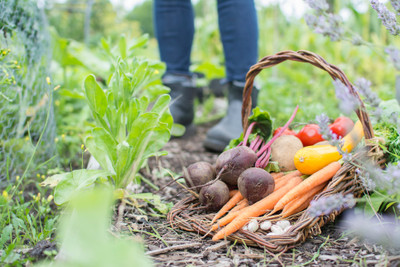Grow Your Own Vegetables
Posted by The Wares Team on 23rd May 2020
In a previous blog post, we talked about how home baking has seen a
surge in interest since the Covid-19 lockdown began in the UK, with
people finding that they have both the time and the enthusiasm to try
some new activities, coupled with a desire for a back to basics approach
to food. Today, we’re going to look at another positive change that has
come out of the lockdown restrictions - the growing interest that
people have in gardening, and in particular, in growing their own
vegetables.
Whether you have a huge patch, an allotment or a window box, there’s
something you can grow yourself and there’s a huge amount of
satisfaction to be had from producing some of the ingredients in the
meals you cook. So read on to discover how easy it is to get started
with growing vegetables and what you can do with those tasty veg once
you’ve grown them.
Let’s start with potatoes
For many new vegetable gardeners, the first place to start is with
potatoes as these aren’t too fussy about soil or aspect, and they grow
reasonably quickly. And of course, pretty much everyone loves potatoes,
which is not something that can be said for every vegetable! To grow
potatoes, you need to source some seed potatoes. As garden centres are
re-opening across the UK, this shouldn’t be a problem.
After chitting them in a dark place for a few days, plant them in
well-dug soil in trenches that are 1ft deep. Leave the dug out soil at
the sides of the trenches in order to ‘earth up’ the potatoes as they
start to grow, starting from when the plants are roughly 15-20cm
tall...You’ll need to do this several times as the stems of the potato
plants grow, covering up about half of the stem each time.
If you don’t have the space to dig traditional beds for your potatoes,
you can grow them in a container, or even in a plastic compost
sack...you’ll still need to earth them up from time to time, but they
should grow well in a sack or container.
Once you have grown and harvested your potatoes, you’ll no doubt want to
enjoy them straight away. Salad varieties are delicious hot or cold,
whilst larger potatoes work brilliantly in soups or as a topping for
meals such as fish pie or cottage pie.
In terms of preserving potatoes, you can dehydrate them to create potato
crisps, or there's the option to can them for use in the winter months.
Use large glass jars for this and ensure you have scrupulously
sterilised those jars before use.
Growing Beans
Another firm favourite with those who grow their own vegetables are
beans. Whether you choose to grow broad beans, runner beans, dwarf
French beans or fancy Borlotti beans, you can’t really go wrong. They
will all need some form of support and you can achieve this using
traditional bamboo canes, or by making a frame using stout poles cut
from your garden trees or shrubs.
Watch out for aphids and greenfly during the growing season and consider
some companion planting if this is likely to be a problem in your
garden. Once your beans start to crop, you’ll need to harvest them
frequently, possibly every day, in order to prevent them becoming tough
and stringy. Again, it’s easy to preserve beans - French beans are great
pickled, whilst kidney beans and Borlotti beans are fabulous for
dehydrating. Check out our range of kitchen utensils for bean slicers to
make life easier if you think you’ll have a huge crop to process.
Growing Salad Crops
Another area of vegetable growing that is quick and easy to try is salad
crops. You can even grow cress and cut-and-come-again lettuce in a
small container on a kitchen windowsill. If you have a little more room,
try a tomato plant in a pot, so that you can easily bring it indoors if
the weather turns bad.
There are even cherry tomato varieties that can be grown in hanging
baskets, so you don’t need any floor space or garden soil at all! Other
salad crops that are quick and easy include radishes, spring onions and
cucumber, although you might find that cucumbers do best if they are
grown in a greenhouse or polytunnel. Chillies are fun to grow too and
since they don’t get too big, you can grow these in pots on a sunny
windowsill indoors.
Even if you don’t manage a comprehensive vegetable patch, there’s a lot
of satisfaction to be had from growing just one or two things to eat,
even if it’s only herbs to throw in your recipes. If you do plan to grow
lots, be sure to stock up on glass jars for preserving your crops, and
check out our range of kitchen utensils for handy tools to help you prep
them all.
Do share your veg-growing adventures with us, via Instagram, Facebook and Twitter - we all love to see your success stories!

